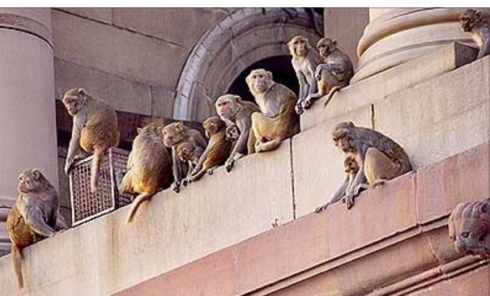To be updated during weekend: Update #3, Friday, Sept. 10, 15:37, Delhi, India, time
Coming Monday

TAKEAWAY: Estilo has a new look and Garcia Media Latinoamerica is proud of its participation in a project leading to this best read magazine of Honduras to hit the reset button and become a true multiplatform publication, enhancing content, reaching for new audiences and attracting more advertisers PLUS: “Surprising” headlines AND: Monkeys, monkeys everywhere
Estilo comes out in style


Honduras’ reference magazine, Estilo, has introduced a new design for both its printed and digital editions. In the hands of Garcia Media Latinoamerica, the project was led by Rodrigo Fino and Paula Ripoll, and this week Estilo appeared with a classy look, and taking advantages of the way magazines can make better use of today’s multimedia environment to serve their readers.
One of Garcia Media’s first steps is to recommend that, while design changes are important and give the publication a chance to hit the reset button, it is also necessary to review content strategies, introduce new concepts and review the publication from top to bottom.
Estilo did just that. The following steps were taken:
1. Creating better synergy between contents in the printed and digital editions. For example, enhancement to contents that cannot be properly done in the printed edition, are now provided through the online edition, such as use of audio and video.
2. Prioritizing which content fits better with what platform.
3. Seeking new audiences through the digital edition, especially through a series of specialized blogs.
4. Making sure that the print redesign presents visual and content rhythm with the online edition.
5. Creating a color palette for all platforms that emphasizes a minimalist aesthetic, simple, compact and used throughout the platforms.
5. Incorporating typographic schemes that can be used in all editions. For Estilo, print edition, the previous font Corporate, was replaced with the fresh Heroun Sans, while the elegant serif Chronicle was maintained.
Rodrigo Fino, Garcia Media Latinoamerica president and project leader, told the group gathered for the launch of Estilo:
Through the new Estilo, advertisers will now be able to capture audiences that they did not before, specifically those who come to the digital edition seeking content that differentiates the online edition from the printed one. This will allow Estilo to reinforce its brand, but also to expand its presence in the web.
Sample the new design here
>>>>>>
<<<<<
See Estilo BEFORE the redesign
>>>>>>
<<<<<<<
Estilo facts
Founded in 1996, Estilo is a magazine devoted to society news and entertainment, with ample coverage of fashion, home decor, food, travel, technology, health and specialized coverage of the country’s personalities and their comings and goings. Since 2001, the magazine belongs to the editorial group Organización Publicitaria, S.A. (OPSA).
Estilo editor in chief is Blanca Bendeck who conceives Estilo as a forum to reflect on Honduran life, its people, as well as topics of interest to both men and women.
To read the Spanish version of Estilo’s redesign:
http://www.garcia-media.com.ar/blog/post/sinergia-con-estilo/122
Some news I thought I would never hear:

Call it “surprising headlines”, but these two items in the news of the past 24 hours show that each day may bring something shocking, a headline that you look at and say to yourself: Am I reading this right? The answer in both cases is yes, however. It will be fascinating to see how these stories play out in the future.
– USA: Sulzberger Concedes: “We Will Stop Printing The New York Times Sometime In The Future”
http://www.businessinsider.com/sulzberger-we-will-stop-printing-the-new-york-times-2010-9
-Fidel Castro says communism doesn’t work
http://www.guardian.co.uk/world/2010/sep/09/fidel-castro-cuba-economic-model
Monkeys, monkeys everywhere


It is raining monkeys in Delhi: residents don’t think it is any fun at all, but I wish my grandchildren were here to take a peek/photo from www.allvoices.com

Extra! Extra! Read all about it: Monkeys make life miserable for Delhi residents
Pardon my fascination with monkeys, but I can’t help to be somewhat amused by the string of stories in the local newspapers here about how monkeys are terrorizing residents, jumping through windows or roofs of homes, and, in some instances, causing injury——they bite and scratch.
Today’s Hindustantimes carries a story headlined: Monkey menace continues in East Delhi, citing that the city only has eight monkey catchers. According to a city official: “it is difficult to recruit monkey catchers because of religious and safety reasons.”
Religious reasons? I asked the locals, and I am told that, indeed, in some parts of India, folklore has it that monkeys are gods, with Tuesdays designated as Worshiping the Monkey God day, when people offer food to the monkeys.
“On Tuesdays and in some cases, Saturdays, many people keep fast in honour of Hanuman—the monkey god—- and give special offerings to him. In times of trouble, it is a common faith among Hindus to chant the name of Hanuman or sing his hymn (“Hanuman Chalisa”) and proclaim “Bajrangbali Ki Jai” — “victory to thy thunderbolt strength”. Once every year — on the full-moon day of the Hindu month of Chaitra (April) at sunrise — Hanuman Jayanti is celebrated to commemorate the birth of Hanuman. Hanuman temples are among the most common public shrines found in India,” according to a report from allabout.com on Lord Hanuman, the Simian God of the Hindus.
“The problem,” Anup Gupta, creative director at the HIndustantimes, tells me, “is that monkeys don’t know when it is Tuesday and the food offered to them, and when it is just a bowl of fruit on the dining room table that is NOT there for them. They just simply appear at your window, make faces, become a nuisance, and that is where the problem comes in.”
As for those langur monkeys
I mentioned earlier this week, the ones brought in as sort of “capos” or machos to scare the other monkeys, one of them was attacked by the monkeys it was supposed to scare.
I guess it could be worse, however.
As I hear about stories from the locals, I now find out that there is also a temple to workship rats in the small northwestern city of Deshnoke, Rajastan’s famous Karni Mata Templeconstructed by Maharaja Ganga Singh in the early 1900s as a tribute to the rat goddess, Karni Mata. People bring in milk and bread to feed the rats.
No rat sightings in Delhi for me yet, not of the temple-status kind, anyway!

Read the National Geographic piece on rats temple:
http://news.nationalgeographic.com/news/2004/06/0628_040628_tvrats.html

I wish they all could be California schools!
-Students in four California school districts trade textbooks for Apple iPads
http://www.macdailynews.com/index.php/weblog/comments/four_california_school_districts_trade_textbooks_for_apple_ipads/
TheMarioBlog post #627